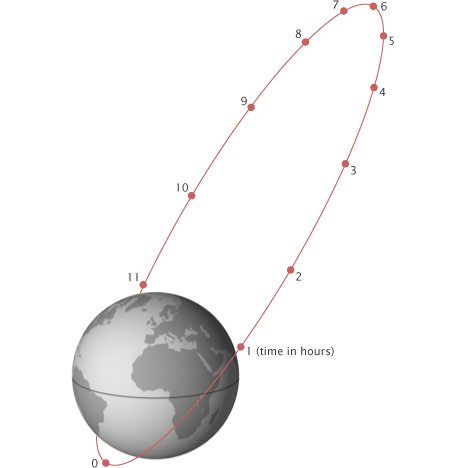[Back to Index]
Geosynchronous/Geostationary Orbit
A common destination for communications satellites, a geosynchronous orbit is a circular orbit where the period is equal to one day.
This gives the satellite the property of staying positioned over the same longitude on the ground.
When the orbit inclination is 0, this is called a Geostationary orbit, as from the ground, the satellite will appear to stay in the same spot in the sky.
To attain a geosynchronous orbit, our period is equal to one day:
T=24hours*60*60=86400seconds
However, the earth does not rotate once in exactly 24 hours, so we use what is called a sidereal day, which is 23.9344699 hours:
T=23.9344699hours*60*60=86164seconds
For an orbit:
T=2π*sqrt((SMa^3)/GM)
86164=2π*sqrt((SMa^3)/GM)
(86164/2π)^2=SMa^3/GM
GM(86164/2π)^2 = SMa^3
SMa=(GM(86164/2π)^2)^(1/3)
therefore geosynchronous orbit has a semi-major axis of roughly:
SMa=42,160,000m, or 42160km
given that the orbit is circular, and subtracting the earth's radius, we get an orbital height of around 35,780km
Low Earth Orbit(LEO)
A low earth orbit is commonly categorized as an orbit between 160 and 2000km above the surface of the earth.
Low Earth Orbit is commonly used for human activities in space, due to less radiation than higher orbits, and less velocity required to attain.
Low Earth Orbit is also desirable for real-time communication satellites, due to the lower latency of signals to satellites at this distance.
As LEO describes any low orbit, it can also be applied to more specific types of orbit, such as a Sun-Synchronous Orbit

[The international space station orbits in LEO, image credit NASA]
Sun-Synchronous Orbit
A sun-synchronous orbit is an orbit where the time of day(mean solar time) of the ground below the satellite stays constant.
These orbits are useful for imaging satellites, as the photography will always be at the same local time, and therefore consistent.
Another advantage of a sun-synchronous orbit is that the spacecraft will always experience the same thermal conditions throughout its mission.
Medium Earth Orbit(MEO)
The range of orbits above LEO, stretching from 2000km up to 35768 km, or the region between geo-synchronous orbit and lower earth orbit
High Earth Orbit(HEO)
The range of orbits at geosynchronous altitude or above
Molniya Orbit
A highly elliptical orbit with a perigee of 495 km, an apogee of 39.587 km, and an inclination of 63.4 degrees, this orbit has a period of 12 hours.
A molniya orbit is used when the needed ground area is above the latitude of that practical for geosynchronous satellites to communicate with.
The orbit is chosen because the satellite will appear to "hover" in a section of the sky during a few hours of the day.
The inclination of 63.4 degrees is designed to cancel out orbit changes due to the fact that the Earth is not perfectly round.

[Diagram of a Molniya orbit, showing time across positions, image credit NASA]
A common destination for communications satellites, a geosynchronous orbit is a circular orbit where the period is equal to one day.
This gives the satellite the property of staying positioned over the same longitude on the ground.
When the orbit inclination is 0, this is called a Geostationary orbit, as from the ground, the satellite will appear to stay in the same spot in the sky.
To attain a geosynchronous orbit, our period is equal to one day:
T=24hours*60*60=86400seconds
However, the earth does not rotate once in exactly 24 hours, so we use what is called a sidereal day, which is 23.9344699 hours:
T=23.9344699hours*60*60=86164seconds
For an orbit:
T=2π*sqrt((SMa^3)/GM)
86164=2π*sqrt((SMa^3)/GM)
(86164/2π)^2=SMa^3/GM
GM(86164/2π)^2 = SMa^3
SMa=(GM(86164/2π)^2)^(1/3)
therefore geosynchronous orbit has a semi-major axis of roughly:
SMa=42,160,000m, or 42160km
given that the orbit is circular, and subtracting the earth's radius, we get an orbital height of around 35,780km
Low Earth Orbit(LEO)
A low earth orbit is commonly categorized as an orbit between 160 and 2000km above the surface of the earth.
Low Earth Orbit is commonly used for human activities in space, due to less radiation than higher orbits, and less velocity required to attain.
Low Earth Orbit is also desirable for real-time communication satellites, due to the lower latency of signals to satellites at this distance.
As LEO describes any low orbit, it can also be applied to more specific types of orbit, such as a Sun-Synchronous Orbit

[The international space station orbits in LEO, image credit NASA]
Sun-Synchronous Orbit
A sun-synchronous orbit is an orbit where the time of day(mean solar time) of the ground below the satellite stays constant.
These orbits are useful for imaging satellites, as the photography will always be at the same local time, and therefore consistent.
Another advantage of a sun-synchronous orbit is that the spacecraft will always experience the same thermal conditions throughout its mission.
Medium Earth Orbit(MEO)
The range of orbits above LEO, stretching from 2000km up to 35768 km, or the region between geo-synchronous orbit and lower earth orbit
High Earth Orbit(HEO)
The range of orbits at geosynchronous altitude or above
Molniya Orbit
A highly elliptical orbit with a perigee of 495 km, an apogee of 39.587 km, and an inclination of 63.4 degrees, this orbit has a period of 12 hours.
A molniya orbit is used when the needed ground area is above the latitude of that practical for geosynchronous satellites to communicate with.
The orbit is chosen because the satellite will appear to "hover" in a section of the sky during a few hours of the day.
The inclination of 63.4 degrees is designed to cancel out orbit changes due to the fact that the Earth is not perfectly round.

[Diagram of a Molniya orbit, showing time across positions, image credit NASA]